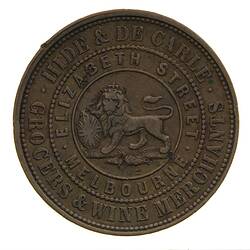Summary
Copper one Penny Token, minted by Heaton & Sons, 1857. Issued by Hide & De Carle, Grocers & Wine Merchants, Melbourne, 1857.
Thomas Hide and Edward De Carle formed a partnership in 1857. They had both been running their own businesses in Melbourne for several years beforehand. They founded a Grocery, Wine and Spirit merchant's business on Elizabeth Street, which lasted until 1861. Their business also included a land and estate agency. Hide and De Carle issued a total of 16 types of penny and half penny tokens, eight in 1857 and eight in 1858. All the tokens were struck by Heaton and Sons of Birmingham.
Physical Description
A round copper token (34 mm diameter) giving the name address and business of the issuer: Hide & De Carle, Elizabeth St. Melbourne, Grocers and wine merchants.. The token features at centre of the obverse a male lion standing to left with head crowned facing front, its right paw is raised and rests on a shield bearing the Union Jack, its tail curved back over its body. On the reverse a female figure representing Justice seated on a wool bale with legs to left but her head and upper body to front. A wine barrel lies on the ground behind her, its end decorated with a cross to hint at a Union Jack (as found beside Britannia on the copper coins of the period). A three-masted sailing ship sails to the right on the horizon to the left. Justice wears a blindfold and extends a balanced set of scales with her right hand. With her left she holds an inverted cornucopia from which fruits flow onto the ground. She wears an ancient-style of flowing dress bound at the waist, her left arm bare and right draped to near the elbow. It bears the date 1857.
Obverse Description
At centre within two concentric rings of text devided by a beaded circle, a male lion standing to left with head crowned facing front, its right paw is raised and rests on a shield bearing the Union Jack, its tail curved back over its body. Around, .HIDE & DE CARLE. GROCERS & WINE MERCHANTS / . ELIZABETH STREET . MELBOURNE
Reverse Description
female figure representing Justice seated on a wool bale with legs to left but her head and upper body to front. A wine barrel lies on the ground behind her, its end decorated with a cross to hint at a Union Jack (as found beside Britannia on the copper coins of the period). A three-masted sailing ship sails to the right on the horizon to the left. Justice wears a blindfold and extends a balanced set of scales with her right hand. With her left she holds an inverted cornucopia from which fruits flow onto the ground. She wears an ancient-style of flowing dress bound at the waist, her left arm bare and right draped to near the elbow. Around above; MELBOURNE, VICTORIA. in exergue; 1857
Edge Description
Plain
More Information
-
Collection Names
-
Collecting Areas
-
Acquisition Information
Transfer from National Gallery of Victoria (NGV), Mr Alfred Chitty, 15 Mar 1976
-
Date Issued
1857 AD
-
Issued By
Hide & De Carle, Melbourne, Greater Melbourne, Victoria, Australia, 1857
-
Mint
Heaton & Sons (Mint), Birmingham, England, Great Britain, 1857
-
Previous Collection
-
Inscriptions
Obverse: HIDE & DE CARLE. GROCERS & WINE MERCHANTS ELIZABETH STREET MELBOURNE Reverse: MELBOURNE, VICTORIA. 1857
-
Denomination
-
Series
-
Material
Copper
-
Axis
06
-
Classification
-
Category
-
Discipline
-
Type of item
-
Dimensions
34 mm (Outside Diameter), 14.721 g (Weight)
-
Shape
Round
-
References
Hide and DeCarle made issues of trade token penny and halfpenny denominations in 1857 and 1858. The tokens were manufactured by Heaton & Sons, Birmingham with well made and difficult to distinguish dies. The year 1857 saw the need for three obverse (called A. B and C) and two reverse (called 1 and 2) penny dies together with two obverse (called D and E) and two reverse (called 3 and 4) halfpenny dies. 1858 saw an additional two penny obverses (F and G) with four new reverses (5, 6, 7 and 8) while one new halfpenny reverse die was called upon (Reverse 9). Die breaks, changes of die alignment and the technique of die linking have permitted the full sequence of production to be suggested (see Sharples NAA 7 pp36 - 40). Token storage reflects the original sequence of production, while earlier catalogues aimed only to catalogue different die combinations. The dies were well made and clearly employed hubbing for the main pictorial elements. However, the entering of the lettering permits die identification even before characteristic breaks. Greatest accuracy of identification is by measuring spacing between certain letters or by specific letter alignment. Andrew's descriptions based on phrases like "less space", "higher" etc. make certainty of identification impossible. Summary of die characteristics 1857 Penny obverse dies Penny Reverse dies Die M to E E to T last T of Street Die E, to V A 3.5 mm 3.7 mm between NT 1 3.7 mm B 6.0 mm 5.8 mm between TS 2 4.3 mm C 3.0 mm 3.0 mm to N
[Book] Andrews, Arthur. 1921. Australasian Tokens and Coins., No. 231
[Book] Heyde, Gilbert C. & Skinner, Dion H. 1967. Unofficial Coins of Colonial Australia and New Zealand., No. 106/1
[Article] Sharples, John P. 1993. A Catalogue of the Trade Tokens of Victoria 1848 to 1862. Journal of the Numismatic Association of Australia. vol.7: p.1-77., V. 70
-
Keywords





